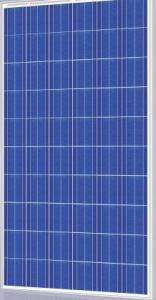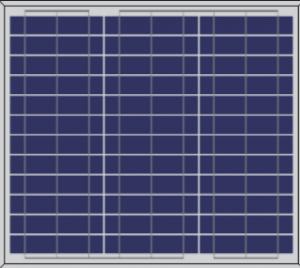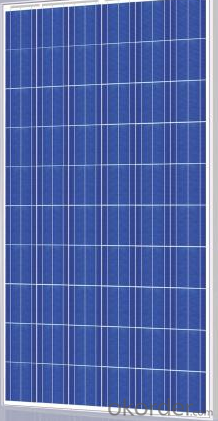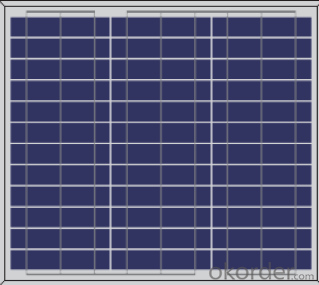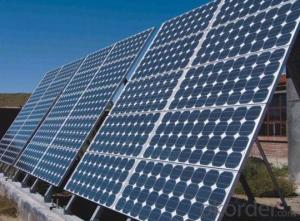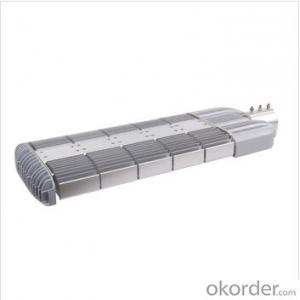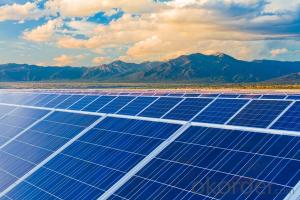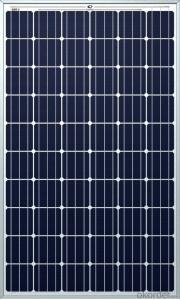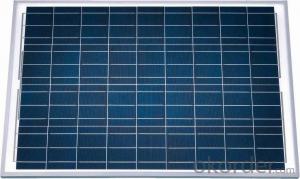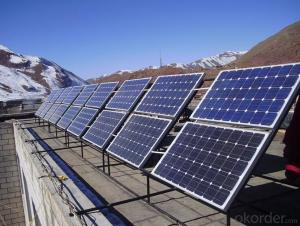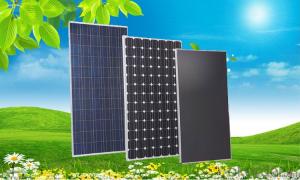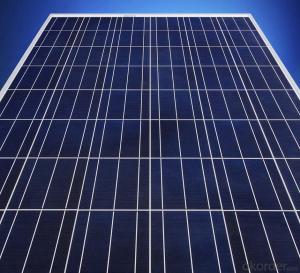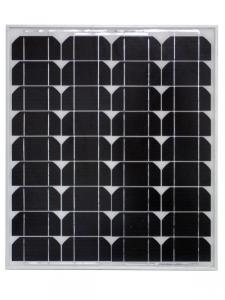30W Poly Solar Panel with Micro Inverters - CNBM Solar Polycrystalline 156 Series
- Loading Port:
- Shanghai
- Payment Terms:
- TT or LC
- Min Order Qty:
- 1 watt
- Supply Capability:
- 100000000000 watt/month
OKorder Service Pledge
OKorder Financial Service
You Might Also Like
CNBM SOLAR is a world-leading and Vertical integrated manufacturer of high-performance with Silicon,Wafer, Cells, Modules, which convert sunlight into electricity for residential, commercial, and utility-scale power generation.
The capacity of CNBMS OLAR is reach to 1GW, and make sure each year our shipment capacity is more than 700-800MWs, at the same time, we have set up the largest solar power station with our partner in Ukraine.
The company is committed to develop and provide the world with clean and renewable energy to ease the energy shortages as well as human kind’s impact on the environment.
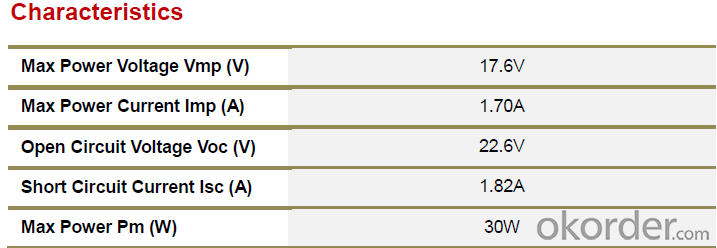
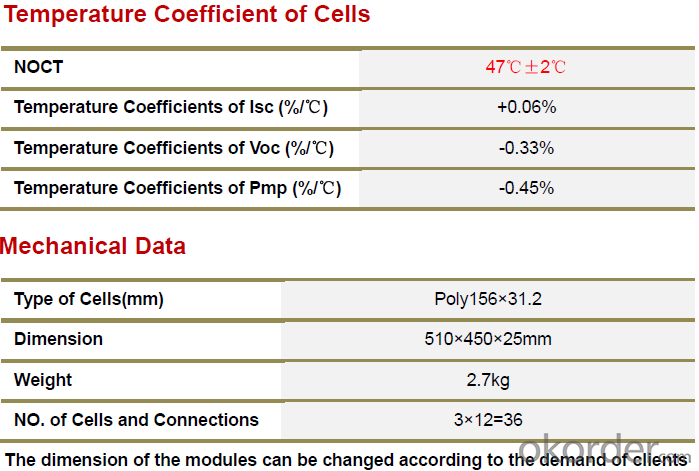
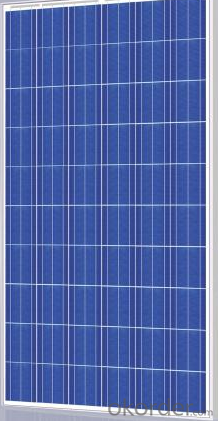
- Q: Can solar panels be installed on a sports stadium or arena?
- Yes, solar panels can be installed on a sports stadium or arena. In fact, many stadiums and arenas around the world have already installed solar panels to generate clean and renewable energy. These panels can be placed on the rooftop, parking structures, or even integrated into the façade of the building. Installing solar panels on sports stadiums and arenas not only helps in reducing carbon emissions and promoting sustainability but also saves on energy costs in the long run.
- Q: if i have a 0 Watt solar panel what does that mean. does that mean it will charge a battery 0 watts per hour? Lets say i hook this up to a car battery and use the car battery to run computer stuff. How much will this charge the battery?
- It will be less than a trickle charger on the battery. It is about .85 amps at 2 volts dc.
- Q: Pls is it ok to connect a 0watt and 20watt solar panel together into a charge controller port, can i just tie the wires together and run into the controller?? Will damage anything...Thanks guys
- Tobi, generally yes, solar panels are like beer, all the europeans get along fine, you can put two Belgiums in the same room as one German and three Englishman. As long as the panels have roughly the same open circuit voltage, usually around 8 volts, then go for it. If you're not sure about this, or the panels voltage disagrees dramatically, then they can still work through the same charge controller, the only other thing you need is a bypass diode in the junction box on the back of each panel. Most modern panels come with these already installed. They are simply electrical check valves, allowing current flow in one direction but not the other. The reason these matter is when the sun is first coming up, the higher voltage panel can force its power backwards through the lower voltage panel, at least until they both reach a voltage higher than the charge controller is set at. This is not a desirable thing to have happen, the 20 watt panel, if its voltage is higher, can damage the 0 watt panel without these diodes if the 20 watt has a much higher open circuit voltage, or Vmax. Look on the back of the panel for these ratings. The only other concern is maximum current. A charge controller has a maximum current it can handle, they are generally model numbered this way, a Xantrex C-60 for example has a 60 amp rating. Add up the Imax numbers on the back of all your panels, this is the maximum amperage the panel should put out. As long as it is not above 80% of your charger controllers maximum amperage, your good. Take care, Rudydoo
- Q: im aware i dont fully understand. but with what i do. if P = iv, and current changes with voltage, whats the point of changing either. if in any cicumstance, you end up with the same wattage, how does changing either effect a solar setup. (2v panel vs 24v)thanks in advance. explain in laymans if you can.
- The choice of solar panel voltage comes down more to what the panels will be connected to. You're right that power can remain the same at the different voltages. Higher input (panel) voltages are sometimes used in inverter systems to reduce the effect of voltage draw-down. 2v panels (about 20v open circuit) work well for charging 2v batteries, connected in parallel, through a charge controller. For use of a grid-tie inverter, higher input voltages are sometimes used to reduce the effects of draw-down. You want to select and wire (parallel vs. series) your panels based on the input voltage requirement of the load, whatever it may be.
- Q: I want to be more green and if I get the panels will I still have a regular electric bill?
- There okorder / Why pay thousands of dollars for solar energy ($27,000 average cost) when you can build your own solar panel system for just a fraction of the retail cost. You can build a single solar panel or you can build an entire array of panels to power your whole house. Some people are saving 50% on their power bill, some people are reducing their bill to nothing. But what’s most impressive is that just by following these instructions some are even making the power company pay them!
- Q: Can solar panels be used for powering a mining operation?
- Yes, solar panels can be used to power a mining operation. Solar energy can be harnessed to generate electricity, which can then be used to power various equipment and machinery required for mining operations. The solar panels would need to be properly sized and installed to meet the energy demands of the mining operation, taking into account factors such as the required power capacity and the availability of sunlight in the location. Additionally, energy storage systems may be necessary to ensure a consistent power supply, especially during periods of low sunlight.
- Q: Are solar panels suitable for residential use?
- Yes, solar panels are highly suitable for residential use. They provide a sustainable and renewable source of energy, reduce electricity bills, and contribute to a cleaner environment. Additionally, advancements in technology have made solar panels more efficient and affordable, making them a practical choice for homeowners.
- Q: Okay, I think I understand what I'm doing, but I want to set up some solar panels on the roof of my garage, the building that gets the most sun, and I want to make sure all my math is correct in determining number of megawatts per year. However, my knowledge of electrical terms in quite n00bish, to say the least.Here is what I think I should be doing.The solar cells come at .75 Watts average power.I will install 4 panels of 64 cells each, with a total of 256 cells.
- For comparison, 36 of these make a normal 2V x 50W panel. Note they are not tabbed. This means you have to find a way to connect them yourself. The tabs are probably spot welded on by the suppliers. A supplier below has kits of these with tabs, as needed to connect them together. These are not suitable for grid connect, because the higher voltage needed makes do it yourself panels a dangerous and litigious thing to have on your roof. Maybe you could buy a smaller pack from the link below to compare tabbed and untabbed and work out what to do. Your power calculation is a bit incorrect because the sun is only present some of the time. The 36 cell module would produce 50W when square on to the full sun. The sun may be out for around 2h a day in some places and times of the year. However it is the equivalent of 5h full sun, because of the changing angle throughout the day. Look this up on the internet for your region. Temperate zones may be a lot less. One pack in your link is 36x3 = 08 cells. Thus 50W per pack x 5h a day gives 750Wh per day and 274KWh/y. In reality it will always be less because of regions, weather, clouds, dust, inefficiencies, aging of cells.
- Q: Can solar panels be installed on greenhouses?
- Yes, solar panels can be installed on greenhouses. In fact, it is a popular practice as it allows for the dual use of land and maximizes energy efficiency. The solar panels can provide electricity for both the greenhouse operations and potentially for other nearby buildings or the grid.
- Q: How could I find out what the amp output of a solar panel? Specifically, I want to know how many milliamps can the solar panel on a Casio fx-260 put out?
- You need full sunshine from the sun, or a lamp that will give a light spectrum similar to the sun, a volt meter, Milli-amp meter, and a variable resistor of 0 to 000 ohms. The voltmeter test leads go across the solar cell leads. The amp meter leads will be in series with the solar cell. Let's say, positive lead of the solar cell to the the positive lead of the amp meter, the negative lead of the amp meter to one terminal of the variable resistor, and the wiper terminal of the variable resistor to the negative lead of the solar cell. Slowly decrease the value of the resistor until the voltage from the solar cell just begins to drop. Take note of the amp meter reading. This is about the high end range of the solar cell. You might want to begin with a micro-amp meter for the current meter.
Send your message to us
30W Poly Solar Panel with Micro Inverters - CNBM Solar Polycrystalline 156 Series
- Loading Port:
- Shanghai
- Payment Terms:
- TT or LC
- Min Order Qty:
- 1 watt
- Supply Capability:
- 100000000000 watt/month
OKorder Service Pledge
OKorder Financial Service
Similar products
Hot products
Hot Searches
Related keywords
